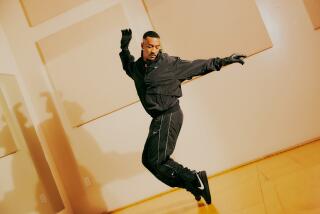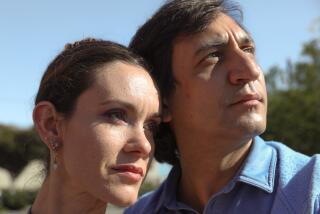Dancer Wendy Whelan leaves ballet, becomes a freelance modernist
In a ballet studio overlooking Grand Avenue downtown, long-limbed, bone-thin Wendy Whelan melts into the arms of her partner, Jared Angle, before sinking into a taut, high backbend off the floor.
Then, in the last moment of their duet, he slides under her and she relaxes into him, as if in peaceful sleep or perhaps united with him in death, like Romeo and Juliet.
Appropriately, it’s an image both contemporary and classic. Over the last 30 years Whelan became a star ballerina at New York City Ballet by excelling not only in the homegrown neoclassical masterworks of George Balanchine and Jerome Robbins but, increasingly, in ballets created for her by such internationally celebrated choreographers as William Forsythe, Christopher Wheeldon and Alexei Ratmansky.
Last month, the 47-year-old Whelan left the company for a career as a freelance modernist. Her final days at NYCB prompted published tributes galore, including one in Vanity Fair from Mikhail Baryshnikov.
“The German sociologist Erich Fromm said that creativity requires the courage to let go of certainties. That’s what Wendy has, in my opinion—courage,” Baryshnikov wrote. “She will definitely grow as an artist, and that’s what it’s all about. It may sound like a silly pun, but when I say there’s a certain grace to these next steps, I mean it in the most sincere way.”
Just after her departure, she joined Angle (a NYCB principal) on Bunker Hill for a weekend of teaching and performing as part of the new dance initiative at the Colburn School, its pre-professional dance academy.
In a class with 12 handpicked young ballet students, she’s meticulous yet spirited, sometimes advising them to curb their eagerness because it resembles children rushing onstage for their first “Nutcracker:” “Don’t distort the step by trying too hard.”
Later, the other extreme: “Don’t be shy, don’t be stingy — be generous.” Fewer than half of them ever saw her onstage, but this is the YouTube generation, so when she commands, “there’s no tension, only intention,” they know who’s speaking and why it matters.
Observers tried to define what made Whelan’s performances unique and perhaps none came closer than her former company colleague Jenifer Ringer — now director of the Colburn Dance Academy.
“She creates an inner world for herself in every ballet and brings the audience into that world,” Ringer said after watching Whelan and Angle rehearse. “There’s so much mental-emotional work in her dancing in addition to the physical-technical work.”
To Angle, “there’s a steely, resolute integrity to everything she does. When I first partnered her, I was shocked at how easy it was — how much in control she is. She’s always in the moment, redefining her reality every day.”
Whelan’s self-assessment is even simpler. “I am open-minded,” she declares. “I try to dig as deep as I can into everything in front of me, and I keep digging at it year after year, decade after decade.”
But she doesn’t want all that work to show onstage. For Whelan a good performance is “when I am completely open and lost in the moment and not thinking about what I’m doing. If I can get lost and feel my body relax and open, I’m in heaven.”
Both tension and intention figure strongly in Whelan’s description of dancing time-honored Balanchine ballets at Lincoln Center. “For example, I had to try to fit myself into a piece of choreography that was made for Suzanne Farrell,” she recalls, speaking of one of Balanchine’s most celebrated ballerinas. “I’m not Suzanne Farrell, not even remotely close. Those are big shoes to try to fit in, and I always struggled with that.”
She remembers being coached by two Balanchine muses (and ex-wives) for a 1993 revival of the Haieff “Divertimento.” First came Maria Tallchief, who gave her “every detail — where my eyelashes should be at every moment, and it was so rich with color, ideas, thoughts, memories, and very design-oriented.”
The next day Whelan showed it to Tanaquil LeClercq. “And she said, ‘Just be yourself.’ And I never forgot that. There are two ways to take on those roles, and I think Balanchine would have wanted both. It’s hard to take that freedom when he’s not there, but in reality that’s what we have to do without him: to make it honest. That’s a huge ingredient in his work — that you are you.”
“All his ballets are abstract, so it’s not like it’s a clear lesson, but I think that from learning the repertory and learning about myself as an artist and a person a lot of it came together in a really interesting way,” she says. “I came out a different person — more articulate — than I ever thought I would be, more knowledgeable about myself and the art form.”
Late in her NYCB career she found herself no longer cast in coveted Balanchine roles and needing a hip reconstruction. Both these setbacks deeply troubled her, she says, but helped persuade her that she had reached a crossroads and should move on.
Whelan admits that she once scorned modern dance (“I didn’t get it, I didn’t understand it”). But now, she finds herself more than ever committed to new movement experiences.
“I’m really interested in being a collaborative part of a work with a choreographer,” she says. “That’s where my passion is — being in a studio and making new ideas come to life.” Dancing with Angle at the Colburn School on Sunday in a duet from Wheeldon’s “After the Rain” represented a down-payment on her plans.
Early in 2015 she will tour with four dancer-choreographers in “Restless Creature,” a program of contemporary duets that is adding dates but is scheduled to be at the Carpenter Center in Long Beach on Feb. 7.
“I am so proud to be able to say that I’m 47 and still dancing,” she says. “This is my vocation since I was 12 years old, maybe 8 or 9. It’s my calling, what I do best. Right now that means taking myself out of the extremities of ballet and putting myself into more habitable movement — less strenuous, more free, more who I am at this point in my life.
“My husband [photographer David Michalek] always says to me you’re an artist first, a dancer second, a ballet dancer third.” Whelan says. “If you’re not a ballet dancer you’re still a dancer. If you’re not a dancer you’re still an artist. So I like to live by those words.”
More to Read
The biggest entertainment stories
Get our big stories about Hollywood, film, television, music, arts, culture and more right in your inbox as soon as they publish.
You may occasionally receive promotional content from the Los Angeles Times.






